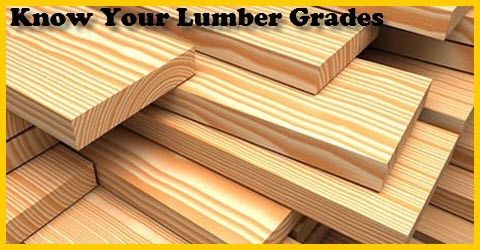.
If A Certain Type Of Lumber Seams Cheap – Be Careful What Grade You Are Buying
Low grade lumber is cheap because in is low quality. Out of a long wide board you may only get a few short pieces suitable for a quality project.
At the saw mill they separate all the boards cut into the different grades.
You can seldom buy the highest grade at the store, it is reserved for various manufacturers or most often for export.
Middle grades are commonly available at any lumber yard and the lowest grades go to pallet manufactures or for some types of fence boards.
There are different grading standards for different species of wood. As well as different grading systems for hardwoods and softwoods.
Here are some of the species grades that are common.
Western Lumber
Known for its ease of workmanship and nailing as well as strength and dimensional stability, Western lumber includes more than 15 commercially important Western softwood species. The most common species are Douglas fir and Hem-fir. This can be classified as High Quality Appearance, General Purpose Board or Radius-Edged Patio Decking Grade. The Western Wood Products Association (WWPA) has a rigorous inspection and quality control process. Lumber with the WWPA logo indicates the lumber has passed that quality control process. Lumber with only the “WWPA Rules” stamp indicates the lumber has been graded according to the WWPA rules, but not been inspected by WWPA.
Use this for basic building projects and framing.
Southern Pine
Southern pine has high strength, resistance to wear and holds fasteners well. It is often used in homes and other structures. Descriptions for this type of wood range from 1 through 4.
No. 1 has the highest quality and best appearance
No. 2 is characterized by tight knots and is generally free of holes
No. 3 is good, serviceable sheathing, usable for many applications without waste
No. 4 contains usable portions at least 24 inches long
Pine Shelving
This lumber is 1 inch thick and of varying widths and lengths. Most consumer inventories range from 1×1-inch to 1×12-inch, up to 12 feet long. From 1×1 to 1×6, increments increase by 1 inch. Then, lengths increase in 2 inch increments from 1×8 to 1×10 and 1x 12. Most consumer sales will be in 4 and 6-foot lengths. No. 4 grade pine is commonly called “garage shelving.” Many people use it for basements and garages where looks are not important.
Back at the original article you'll find info on redwood and treated lumber as well
Go to the next page to understand hardwood ordering — watch the video
.
